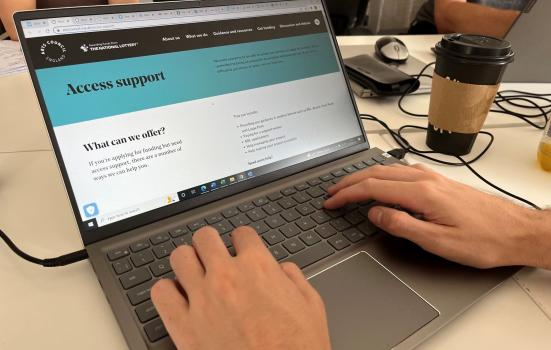Many funders are changing their strategies around funding for arts organisations, but Michelle Wright thinks those changes inadvertently work against widening reach.

We seem to be in a rather bizarre time. Many funders are changing their strategies to specifically support more diverse-led organisations, yet the funding model to apply is often antiquated, favouring applicants that are well versed in preparing high-level written applications.
Of course, the trustees of funding organisations have to meet the requirements of the Charity Commission. They need to give money away well, making sure that their due diligence in doing so is adequate and proportional to the funds granted and that they can evaluate the impact.
Yet, in so doing, some grant making systems are incredibly onerous, favouring a highly structured written narrative that often needs to be completed to a short turnaround. The system therefore not only favours the skilled writer, but also resource-rich organisations that have expert staff in place.
As we consider a rights-led equality agenda, it’s apparent that many of our funding systems have not embraced some of the principles of the Disability Discrimination or the Equality Act. The Equality Act introduces the requirement for employers and service providers to make reasonable adjustments to make them physically and intellectually accessible.
Barriers to access in funding
In Creative Future’s Barriers to Access report 2015, respondent artists and writers described the ‘huge challenge’ of completing funding applications which many described as ‘frustrating’ or ‘overwhelming’, as well as the perceived inequalities surrounding funding decisions.
It is estimated that 1 in 7 people in the UK are neurodivergent. Neuk Collective, a group of neurodivergent artists based in Scotland, recently conducted a survey to demonstrate how ‘a career in the arts consists of organisational tasks that makes the sector less accessible to neurodivergent artists’.
50% of respondents had experienced difficulties in accessing funding, as well as unfeasible workloads/pace of work. Tzipporah Johnston, said: “The art world is particularly difficult for neurodivergent people to navigate because it’s not really designed with us in mind.”
Neuk Collective suggested including administrative support with writing applications (91%) and tailored funding opportunities for neurodivergent artists (91%). The use of access riders can be a helpful way for artists to communicate their individual access needs to funders and there are some standard accessibility processes that can help, for example audio, Easy-Read and videos.
What is good practice?
Arts Council England (ACE) provides a number of different forms of access support which range from providing guidance in accessible formats such as BSL, Braille, Easy-Read and Large Print, to paying for a support worker.
One example is the easy-to-read guidance document it produced for its National Lottery funded programme, Elevate. ACE also funds CRIPtic Arts to provide application support to d/Deaf and disabled artists.
Yorkshire based organisation, Unlimited supports learning disabled artists and specifically offers applicants financial support to access its own funding application process. Similarly, Jerwood Arts is another exemplar in providing access support.
Onerous processes don’t make for good decisions
In a report called Drowning in Paperwork, Distracted From Purpose, Project Streamline highlights how grant makers sometimes have unclear guidelines, request information that isn’t ultimately used, or ask for information that can be found easily on the internet.
Yet despite the overload of information provided, a 2019 survey found that funders struggle to rank grants reliably while following the current processes. As such, in the health sector there are movements towards video-based applications, such as those already used by the National Lottery Community Fund which would significantly reduce proposal writing time and potentially improve quality.
The use of video might favour the arts, where often the cry is but “where do we actually write about the art in this process?” Video has a proven capacity to convey abstract information, overlay audio commentary and display data that is challenging to do in text.
There is a risk of course that video-based applications favour those with the greatest technical facility or amplify bias. However, even modestly created videos are likely to be more effective communication tools than static narrative and the researchers argue that video might in fact reduce bias as reviewers of written text tend to fall back on tangible measures such as track record or their prior knowledge of an organisation when they become overwhelmed with written narrative.
Competition and peer support model
The risk aversion shown by funders can be frustrating. While funders are obliged to make prudent use of their assets, they are also uniquely positioned to take risks and, unlike private sector businesses that have to report to shareholders, they have high discretion to try new things.
The Grand Challenges model set up its Explorations programme in 2008. This requires only a two-page application with no preliminary data to support the most promising new ideas in health innovation with initial grants of $100k and then follow-on support.
The foundation finds that it receives exceptionally innovative and ambitious proposals because challenge applicants are aware that they are competing against others in the quality and impact of their ideas, rather than in their preliminary data and results. Such an approach is also used by funders such as the Knight Foundation, the X Prize Foundation and Ashoka Changemakers.
In contrast, the Rockefeller Foundation, uses its grantees to help with scanning, providing additional funding to a group of ‘searchlight partners’ who report back from the front lines about the latest trends and opportunities.
Other organisations, such as Ashoka, the MacArthur Foundation, and the Open Society Foundations, use fellowship programs to find breakthroughs. Similar to the world of venture capital, they invest in innovative and entrepreneurial leaders, rather than in specific ideas, and provide those leaders with relatively unrestricted support to pursue their interests.
Time for change
If we want to ensure a redistribution of funding and a regeneration of the arts sector, then accessibility of process, excellent ideas generation and generous peer support will be essential parts of our funding mix. Surely the time has come to radically experiment with our application processes as a first step to change.
Michelle Wright is CEO of Cause4 and Programme Director of the Arts Fundraising & Philanthropy Programme.
(Research by Rebecca Ward)
![]() artsfundraising.org.uk
artsfundraising.org.uk
![]() @artsfundraising | @MWCause4
@artsfundraising | @MWCause4
This article is part of a series on the theme Fundraising for the Future, contributed by Arts Fundraising & Philanthropy.





